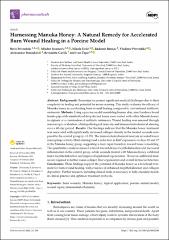| dc.contributor.author | Privrodski, Boris | |
| dc.contributor.author | Jovanović, Mladen | |
| dc.contributor.author | Delić, Nikola | |
| dc.contributor.author | Ratajac, Radomir | |
| dc.contributor.author | Privrodski, Vladimir | |
| dc.contributor.author | Stanojković, Aleksandar | |
| dc.contributor.author | Gavlik, Bernadeta | |
| dc.contributor.author | Čapo, Ivan | |
| dc.date.accessioned | 2025-02-27T10:18:25Z | |
| dc.date.available | 2025-02-27T10:18:25Z | |
| dc.date.issued | 2025-02-21 | |
| dc.identifier.citation | : Privrodski, B.; Jovanovi´c, M.; Deli´c, N.; Ratajac, R.; Privrodski, V.; Stanojkovi´c, A.; Gavlik, B.; Capo, I. ˇ Harnessing Manuka Honey: A Natural Remedy for Accelerated Burn Wound Healing in a Porcine Model. Pharmaceuticals 2025, 18, 296. https:// doi.org/10.3390/ph18030296 | en_US |
| dc.identifier.issn | 1424-8247 | |
| dc.identifier.uri | https://repo.niv.ns.ac.rs/xmlui/handle/123456789/952 | |
| dc.description.abstract | : Backgrounds: Burn injuries present significant medical challenges due to their
complexity in healing and potential for severe scarring. This study evaluates the efficacy of
Manuka honey in accelerating burn wound healing compared to conventional antibiotic
ointments. Methods: Using a porcine model resembling human skin, nine Landrace breed
female pigs with standardized deep dermal burns were treated with either Manuka honey
in alginate or a combination of antibiotic ointments. Wound healing was assessed through
macroscopic evaluation, a histopathological analysis, and immunohistochemical staining
over a 60-day period. Results: Our findings indicate that the Manuka honey treatment
was associated with significantly increased collagen density in the treated wounds compared to the control group (p < 0.05). The immunohistochemical analysis revealed lower
macrophage activity (Iba1 staining) and a reduction in Ki67 expression on days 10 and 17
in the Manuka honey group, suggesting a more rapid transition toward tissue remodeling.
The quantitative analysis showed a trend toward delayed epithelialization and increased
inflammation in the control group, while wounds treated with Manuka honey exhibited
faster reepithelialization and improved epidermal regeneration. However, additional studies are required to further assess collagen fiber organization and overall dermal architecture.
Conclusions: These findings support the potential of Manuka honey as a beneficial treatment for burn wound healing, with evidence of enhanced reepithelialization and collagen
deposition. Further research, including clinical trials, is necessary to fully elucidate its role
in clinical practice and optimize treatment protocols. | en_US |
| dc.language.iso | en | en_US |
| dc.publisher | mdpi | en_US |
| dc.source | Pharmaceuticals | en_US |
| dc.subject | burn wounds | en_US |
| dc.subject | Manuka honey | en_US |
| dc.subject | topical application | en_US |
| dc.subject | porcine animal model | en_US |
| dc.subject | wound repair | en_US |
| dc.subject | immunohistochemistry | en_US |
| dc.title | Harnessing Manuka Honey: A Natural Remedy for Accelerated Burn Wound Healing in a Porcine Model | en_US |
| dc.type | Article | en_US |
| dc.identifier.doi | 10.3390/ph18030296 | |
| dc.citation.volume | 18 | en_US |
| dc.citation.issue | 296 | en_US |
| dc.citation.rank | M21 | en_US |
| dc.type.version | published | en_US |

